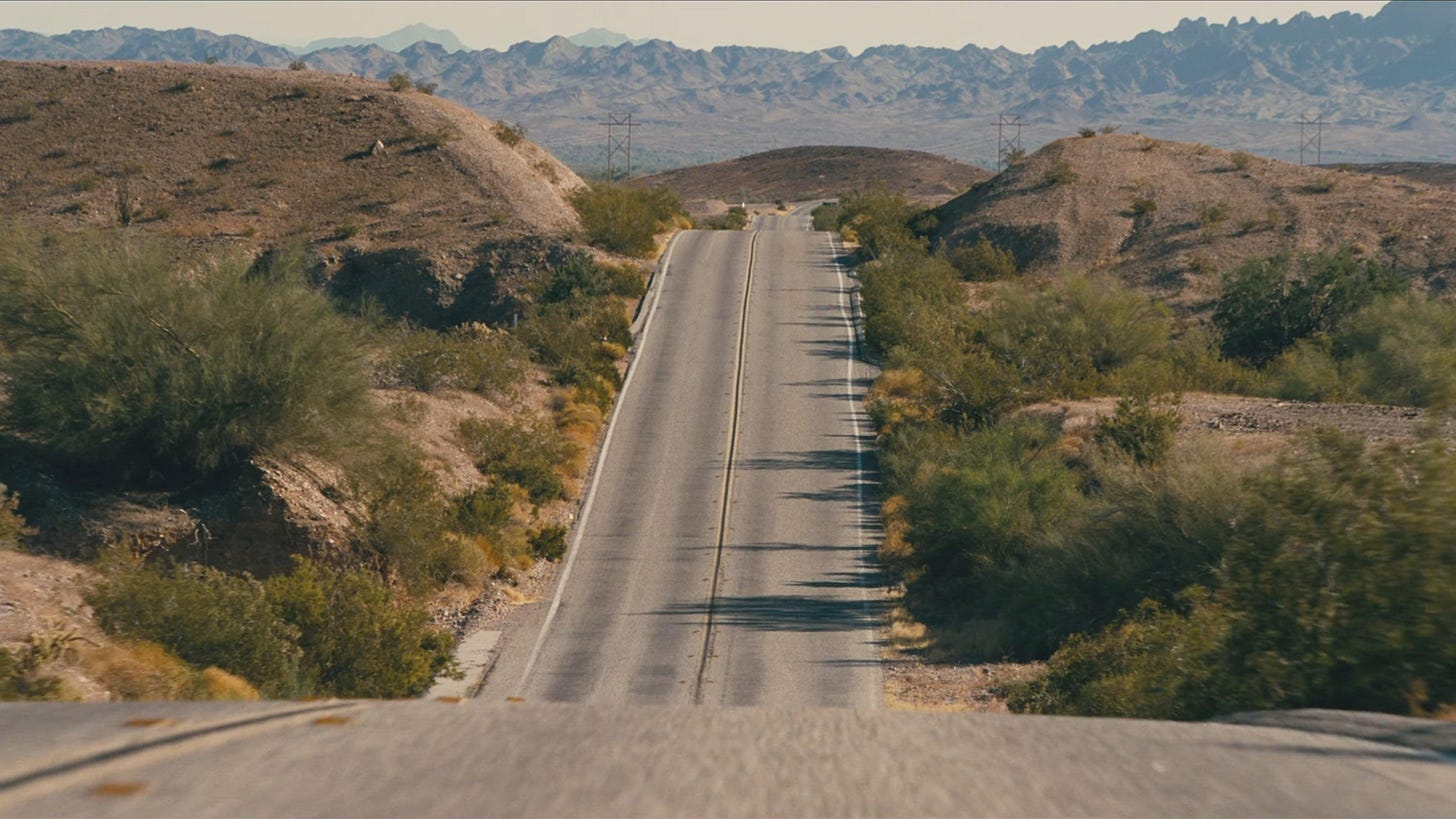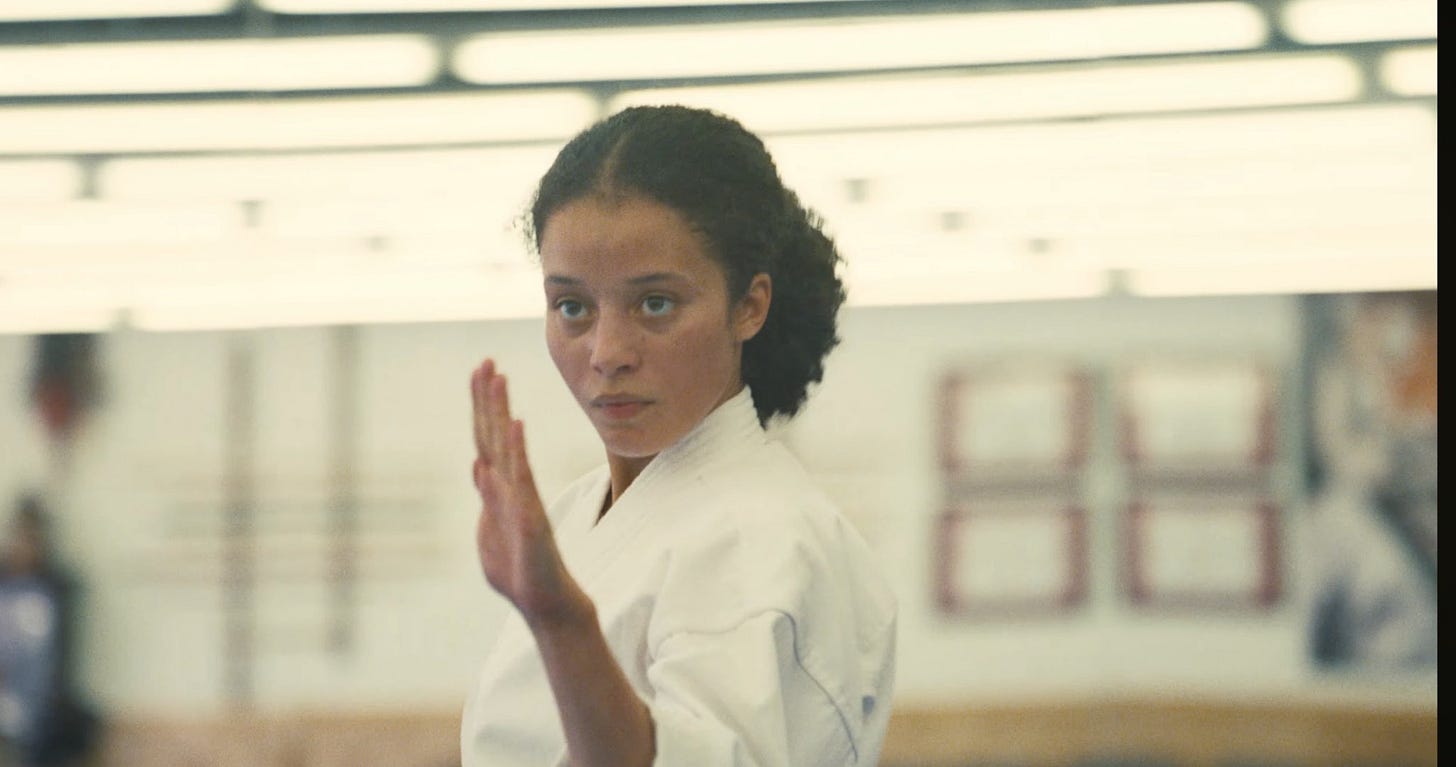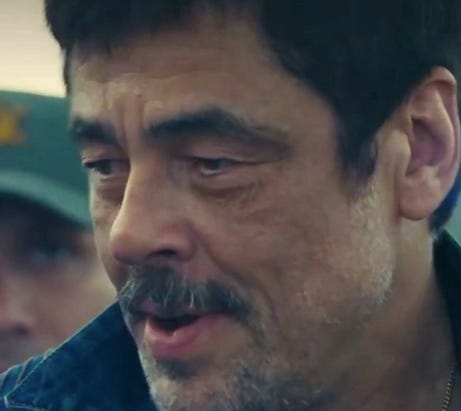If you put Paul Thomas Anderson’s films alongside each other you’d have a shadow history of California. Featuring deranged oil prospectors, insurgent revolutionaries, stoned detectives, religious cults, the pornography industry, corrupt cops, struggling businessmen and self-help gurus, his films tend to depict people living in extremity, ascending – or failing to ascend – through the ranks of West Coast American culture through either sheer willpower or dumb accident, and sometimes a combination of the two. Unlike the films of Michael Mann, whose protagonists are always very good at what they do, Anderson’s heroes and heroines tend to grapple awkwardly against or with broader social or political forces to make their way, and when they get what they want they don’t necessarily like it. They also tend to exist within a large mesh of people, a loose network of makeshift families and alliances who either act as a bulwark against the world at large (Boogie Nights, Licorice Pizza) or as an obstacle to their progress (There Will be Blood, Phantom Thread).
The obvious cinematic antecedents to Anderson’s Californian films are from the 1970s. Altman’s California Split and The Long Goodbye, Ivan Passer’s Cutter’s Way and Hal Ashby’s Shampoo; these are films about transient and disoriented characters bouncing around Southern California, simultaneously dreaming of a way to transcend their circumstances while also semi-aware that to do so would be catastrophic. Anderson’s earlier work makes an approximation of these films’ form – a floaty, loose style, a warm use of light, mobile camerawork and a shaggy-dog approach to plotting. Around the time of There Will Be Blood, Anderson’s films get flintier, hard surfaced and jagged. The orange sunlight of the earlier work bleaches out into something thinner and chillier. The curved edges of furniture and fashion sharpen and darken, and the structures of the films become less watertight. Boogie Nights and Magnolia are satisfyingly tidy, neat and circular. With Punch-Drunk Love, Anderson’s style begins to hint at something more elliptical, signifying changes of mood with inserts of abstract patterns of light and colour. For all its reception as a ‘classic Hollywood movie’, There Will Be Blood is fascinatingly structurally lopsided, with a propulsive first hour giving way to a meandering second, before a bizarre epilogue which flirts with outright slapstick. The Master, rather than the Scientology exposé people were expecting, is a film that repeatedly refuses to pull the trigger on the true nature of its protagonists’ relationship, opting instead for a series of sublimated and downright weird veiled exchanges, in which neither party directly vocalises their feelings towards the other.
With this propensity towards shaggy-dog stories, West-Coast settings, loose narratives and confused characters, it’s unsurprising to learn that Anderson is a fan of Thomas Pynchon. Although Pynchon is often associated with California – his novels The Crying of Lot 49, Vineland and Inherent Vice are all California-set – his origins are as East Coast as they come. A Long Island kid who studied at Cornell, Pynchon is a descendant of Puritans from the Massachusetts Bay Colony, and his extended family was the model for the ‘Pyncheons’ in Nathaniel Hawthorne’s novel House of the Seven Gables. Footloose in his earlier years, living in, among other places, Washington (where he was a technical writer for Boeing) and Mexico, Pynchon now lives in Manhattan. But it’s his time in Manhattan Beach, California in the 1960s and 70s, where he wrote his magnum opus Gravity’s Rainbow, that influences both his own West Coast novels and Anderson’s adaptations of his work, 2014’s Inherent Vice and this year’s One Battle After Another, a very loose adaptation of his 1990 novel Vineland. Anderson, who was born in Los Angeles in 1970, arrived in the immediate aftermath of the world depicted in Inherent Vice and The Crying of Lot 49. Part of what’s so interesting about his adaptation of Inherent Vice is the tension between Anderson’s often nostalgic reconstruction of early ‘70s Manhattan Beach and Pynchon’s more fatalistic return to the breaking of the countercultural wave, a time through which he lived and in which much of his style and melancholy philosophy is formed. Pynchon’s later work admits a greater degree of tenderness towards the past, unlike the oblique narrative structures of V, Lot 49 and Gravity’s Rainbow, which are more often concerned with the impossibility of knowing or discovering the whole shape of a secret or coded social framework. In this sense, the later Pynchon novels are a better fit for Anderson’s style, as their haziness and loose-footed comedy meets the latter’s fascination with the recent history of his home state.
While Inherent Vice was a largely faithful adaptation, One Battle After Another takes the basic structure of Vineland – retired hippie insurgent forced back into action when his daughter disappears, requiring him to come to terms with his partner/her mother’s complicity with the forces of political and military repression – updates it to the present day, and uses it as the basis of by far the most action-oriented film Anderson has made. Featuring two bravura set pieces, one a near thirty-minute night pursuit and the other a delirious car chase taking place on a vast highway, the film is the obverse of the languid anti-mystery of Inherent Vice, where Joaquin Phoenix’s Doc Sportello spends a great deal of time sitting or lying down in a fug of dope smoke. Vineland is closer to Inherent Vice in terms of its tone; its protagonist Zoyd Wheeler is more Sportello-like on the page than his analogue in One Battle, the reluctant action hero Bob Ferguson (Leonardo DiCaprio), who goes in search of his partner in revolution and life, Perfidia Beverley Hills (Teyana Taylor), and their missing daughter Willa (Chase Infiniti, which sounds like a name Pynchon might have come up with).
Chase Infiniti as Willa Ferguson
To a casual viewer, One Battle could easily be taking place in the 1970s. Apart from a few cursory references to cellphones and a couple of fairly on-the-nose references to contemporary language policing, the film retains the hazy, watery ‘70s look of Licorice Pizza and Inherent Vice. Anderson’s decision to shoot the film in VistaVision, a 1950s celluloid format where the film is projected laterally to afford a larger frame and greater image resolution, adds to a prevailing sense of what we might call a ‘vintage’ look. But unlike, say, Tarantino, whose Once Upon a Time In Hollywood was, like much of his later work, pretty much nothing but empty fetishism, Anderson plays upon the disjuncture between the vintage aesthetic and the film’s contemporary setting. When Stephen Lockjaw, the film’s military antagonist – played by Sean Penn in a rivetingly muscly and chewy performance – produces a portable DNA testing machine, it looks like something that’s been pulled through a wormhole in time. This effect recalled to me Alex Cox’s Walker (1987), in which William Walker’s 19th century invasion of Nicaragua features abrupt anachronisms like assault weapons and Diet Coke, the better to draw an analogy with the Iran-Contra affair unfolding at the time. Anderson’s film is not as directly politically systematic or analogous as Cox’s, but the convergence of vintage format and contemporary paraphernalia produces a political synthesis that occurs at the level of mise-en-scene rather than through verbal articulation and is – for me at least – the better for it.
It’s One Battle’s political dimension that has drawn particular attention since its release. There is such an obvious analogy to the horror currently unfolding in the US that critical opinion has been split around whether Anderson’s film – which was, of course, shot before the last election – is radical enough. This, as with much contemporary online film ‘discourse’, often comes down to a preoccupation with the film one has imagined in one’s head, rather than what the actual film is doing, and Anderson’s canonisation on film websites and social media as one of the contemporary ‘GOATs’ of filmmaking hasn’t exactly helped this situation. I’ve often felt that the deep seriousness and acclaim that There Will Be Blood received knocked the subsequent reception of Anderson’s films somewhat askew. That film, for me, is a lot funnier – even sillier – than many critical accounts give credit for, and there’s always been an impish quality to Anderson’s work that refutes the stolid seriousness of purpose that attends, say, the work of Denis Villeneuve or Christopher Nolan. Much of There Will Be Blood – Daniel Day-Lewis being repeatedly slapped in the face in church, Paul Dano’s strangulated yelps, the final clobbering of Dano with a bowling pin – owes as much to The Three Stooges as it does to Upton Sinclair or John Ford. It’s for this reason that I think Licorice Pizza’s critical notices were somewhat mixed – Anderson made a fairly cosy coming-of-age romantic comedy that the GOAT-people found insufficiently serious after the statelier Phantom Thread, despite that film being outright campy in places (Reynolds Woodcock, indeed). Perhaps the best idiom for Anderson’s post-There Will Be Blood filmography is ‘absurd’, a history of oddballs, freaks, radicals and megalomaniacs, with no serious distinction between those in charge and those acting as insurgents. Lockjaw – a white supremacist whose political aims are fatally compromised by the fact that he is sexually attracted to Perfidia, who is Black – is a profoundly absurd character, all the way down to Penn’s outrageously silly walk. This absurdity is a quality that Anderson shares with Pynchon, whose antagonists often veer between the personification of satanic evil and pathetic, craven worms. The ‘Christmas Adventurers’ in One Battle, a cabal of white supremacists who clearly wield significant political power, are presented as both a great social malignancy and a group of mendacious children playing at their secret club. Just because you’re in charge, Pynchon suggests, it doesn’t mean that you aren’t an absurd individual.
“A few small beers”
Conversely, one of the aspects of One Battle that I enjoyed most was Anderson’s depiction of the communities of people forged in solidarity and opposition to this great absurdity, and in particular, Benicio del Toro’s performance as community leader Sergio St. Carlos. Del Toro plays St. Carlos without any of the agitation of Penn or DiCaprio; he’s a man who knows he is where he belongs, and while others flail and lash out, the community that he has built around himself affords him a quiet gravity. In a much-discussed moment late in the film where del Toro is arrested, Anderson frames him awaiting his detention while skipping in the road, carefree, before cutting to a close-up as the police question him. When asked if he’s had anything to drink, he says ‘a few small beers’, his face a picture of happy resignation. He’s done his work. It’s a moment of great contentment, all the more remarkable considering the dire situation that he’s in. It’s also, arguably, the most heartfelt and least absurd moment in the film.
What I’m saying here, albeit in a roundabout way, is that it’s not a particularly fruitful enterprise to expect Anderson to make The Battle of Algiers or Punishment Park. Instead, the seriousness of his work – and this is, ultimately, a serious film – comes from this particular iteration of absurdity. It might be worth thinking here of another famous Anderson, whose films are often described as insufficiently political because of their highly curated mise-en-scene (full disclosure – I’ve not seen all of The Phoenician Scheme, but the scene where a man is blown abruptly in half by an explosion wouldn’t be out of place in One Battle). The argument that One Battle is not sufficiently politically engaged comes from a critical position that tends to imply that a ‘political’ film is more a genre with specific rules and boundaries that must be followed, rather than a sensibility that can infuse a film of any type. This more dogmatic position finds it hard to countenance the absurdity that I’ve talked about here, because it’s easily aligned, from this perspective, with glibness or facetiousness. But I think Anderson’s film is anything but glib – it’s big-hearted and sincere, and, like Pynchon, he knows that aesthetic pleasure and comedy can be corollaries to political work. I keep thinking of the final chase scene, in which the camera, strapped to the front of a car, speeds along an undulating highway towards a final showdown. We expect the enemy in the dip behind every successive hill, and when they don’t appear we feel a pleasurable jolt of relief. But we know they are coming, and, as we enjoy the rollercoaster, we gird ourselves for the fight.





I'll mention another great Anderson, who also plied the political and absurd -- Lindsey Anderson.
How can you resist the absurdity, as you say, in which a group of powerful men can order kills, and also are captivated by the 'semen demon!'